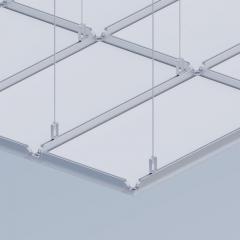

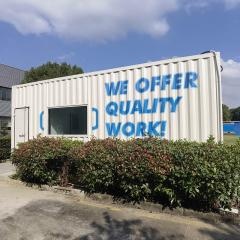
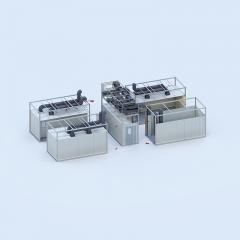
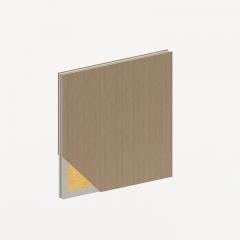
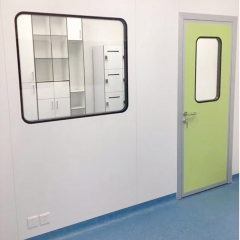

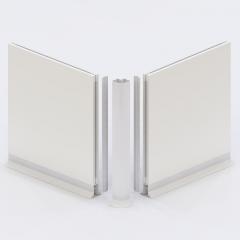

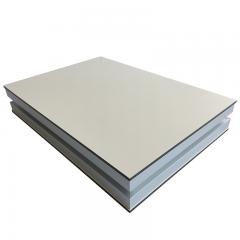
The global construction industry is witnessing remarkable advancements in the field of sandwich panel technology. Two highly innovative types gaining popularity are clean room sandwich panels and HPL (High-Pressure Laminate) sandwich panels. These panels, widely used in various sectors, including healthcare, pharmaceuticals, and food processing, are revolutionizing the construction landscape in Bangladesh. This article explores the key features, design aspects, and benefits of these sandwich panel varieties, highlighting their significant contributions to the country's building infrastructure. Clean Room Sandwich Panels Clean room sandwich panels are specifically designed to ensure high levels of cleanliness for specialized environments such as laboratories, operating theaters, and pharmaceutical manufacturing facilities. These panels are constructed with precision, incorporating durable materials that prevent the accumulation of contaminants and provide superior hygienic conditions. The core material, usually made of polyurethane (PU) or expanded polystyrene (EPS), offers excellent insulation properties for temperature control and noise reduction. The cladding material, often composed of galvanized steel or aluminum alloy, provides added strength and resistance to corrosion. These panels also feature successful integration of doors, windows, and other necessary elements, making them highly practical for clean room applications. HPL Sandwich Panels HPL sandwich panels, on the other hand, are becoming increasingly popular due to their aesthetic appeal and versatile applications. HPL is a composite material made by applying high pressure and heat to multiple layers of kraft paper, impregnated with thermosetting resins. These panels offer a wide range of colors, patterns, and textures, allowing architects and designers to create visually appealing facades and interiors. HPL panels are also highly durable, resistant to scratches, impacts, and UV radiation, making them ideal for commercial buildings, hotels, and restaurants. Their easy installation process, low maintenance requirements, and eco-friendly characteristics further contribute to their growing demand in Bangladesh's construction industry. Design Advancements in Sandwich Panels With continuous research and development in sandwich panel technology, innovative design solutions are emerging to enhance the functionality and performance of these panels. Advanced manufacturing techniques allow for precise customization of dimensions, profiles, and surface finishes, catering to specific project requirements. Moreover, the integration of insulation materials like polyurethane (PU) results in improved energy efficiency, ensuring optimal thermal comfort within buildings. Modern sandwich panel designs also focus on superior fire resistance, sound insulation, and moisture control, providing safer and more comfortable living and working environments. These advancements in design have significantly contri...
As the dawn of a brand-new year approaches, our company stands on the cusp of great possibilities and exciting opportunities. It is with joy and anticipation that we bid farewell to the past and embrace the promising future that lies ahead. With the arrival of the new year, we reflect on both our achievements and lessons learned in the previous year, celebrating the milestones we reached and the challenges we overcame. It is through the collective effort and unwavering dedication of our team members that we have been able to progress and evolve as a company. In the spirit of renewal, the new year brings forth a renewed commitment to excellence and innovation. We pledge to continue delivering top-notch products and services, exceeding customer expectations and setting new industry standards. Our company's success is built upon this unwavering pursuit of excellence, and we are ready to rise to new heights in the coming year. As we navigate through the ever-changing business landscape, we remain steadfast in our dedication to sustainability and environmental consciousness. We understand the importance of responsible practices and strive to implement greener initiatives throughout our operations. By embracing sustainable strategies, we aim to contribute positively to our planet and inspire others to do the same. Furthermore, the new year also presents an opportunity to strengthen our relationships, both within our organization and with our valued clients and partners. We value the trust and support that has been bestowed upon us, and we are committed to nurturing these connections in the years to come. Together, we can continue to forge fruitful collaborations and achieve mutual success. As we embark on this fresh chapter, we recognize that our employees are the bedrock of our company's success. We extend our sincerest gratitude to each and every member of our team for their unwavering dedication, passion, and resilience. It is through their collective efforts that we have been able to accomplish remarkable feats and overcome obstacles. In conclusion, the beginning of a new year brings forth a sense of optimism and renewed vigor. We look forward to embracing the challenges and opportunities that lie ahead, building upon our past successes, and creating a brighter future for our company. Together, let us march into the new year with confidence, unity, and a shared vision for greatness. Happy New Year! clean room door manufacturer、clean room panel manufacturers、clean room modular wall systems、modular clean room manufacturers etc.
The cleanroom environment plays a crucial role in various industries, ensuring the highest standards of hygiene and safety. Among the key components that contribute to a well-designed cleanroom are the ceiling systems. In this article, we will focus on cleanroom ceilings, specifically discussing sandwich panel ceilings, aluminium ceilings, and cleanroom ceiling grids. When it comes to cleanroom ceilings, one popular option is the sandwich panel ceiling .This type of ceiling consists of two metal sheets with an insulating core material in between. It provides excellent thermal and acoustic insulation, while also offering a smooth and hygienic surface that is easy to clean. Sandwich panel ceilings are known for their durability and resistance to moisture, making them ideal for cleanroom environments where precision and cleanliness are paramount. Another common choice for cleanroom ceilings is aluminium ceilings. These ceilings are lightweight, yet sturdy, making them suitable for cleanroom applications. Aluminium ceilings are highly customizable, allowing for various designs and finishes. They are also easy to install and maintain, making them a cost-effective solution for cleanroom projects. Additionally, aluminium ceilings offer good fire resistance properties, further enhancing the safety aspect of cleanroom facilities. To ensure proper installation and functionality of cleanroom ceilings, a cleanroom ceiling grid system is utilized. The cleanroom ceiling grid provides structural support for the ceiling panels, creating a uniform and level surface. It is designed to meet the specific requirements of cleanroom environments, including load-bearing capabilities and compatibility with cleanroom lighting fixtures and air diffusers. The cleanroom ceiling grid system is engineered to withstand the stringent demands of cleanroom operations while maintaining a sterile and controlled environment. In conclusion, cleanroom ceilings are a critical component of cleanroom design. Sandwich panel ceilings offer excellent insulation and durability, while aluminium ceilings provide versatility and ease of installation. The cleanroom ceiling grid system ensures proper support and functionality of the ceiling panels, maintaining the integrity of the cleanroom environment. By carefully selecting and implementing these cleanroom ceiling systems, industries can create cleanroom facilities that meet the highest standards of cleanliness and safety.
In the realm of cleanroom construction and design, meticulous attention to detail and the use of high-quality materials are paramount. This is especially true when it comes to creating an environment that is not only functional but visually appealing as well. Two key elements in achieving this delicate balance are HPL false ceilings and cleanroom HPL wall panels. Let's explore the significance of these elements and their contribution to the overall aesthetics and functionality of cleanroom spaces. First and foremost, HPL false ceilings serve as an essential component in creating a clean and structured environment within laboratories and critical cleanroom areas. High-pressure laminate (HPL) false ceilings offer remarkable durability, resistance, and ease of maintenance. They are engineered to withstand the rigors of a controlled environment, providing a reliable solution that ensures long-term performance. This distinctive ceiling system effectively conceals unsightly building services, electrical wirings, and HVAC ductwork, creating a seamless and visually appealing overhead surface. Moreover, the use of HPL ceiling panels offers an added advantage in terms of customization and design flexibility. With a wide array of colors, patterns, and textures available, HPL ceiling panels can be tailored to complement the overall aesthetic vision of the laboratory space. Whether it is a sleek and modern design or a more traditional and refined look, HPL ceiling panels can be customized to elevate the visual appeal of cleanroom environments while still maintaining the necessary functional requirements. Moving on to cleanroom HPL wall panels, a similar level of attention is placed on their selection and installation. These panels provide an additional layer of sophistication and cleanliness to the laboratory space. Cleanroom HPL wall panels are designed to meet stringent cleanroom standards, offering excellent resistance to chemicals, impact, and moisture. This ensures that the walls remain hygienic, durable, and easy to clean, vital factors in maintaining the integrity of the cleanroom environment. Furthermore, cleanroom HPL wall panels contribute to the overall aesthetics by offering a range of color options that can seamlessly integrate with the laboratory's design theme. This allows for a cohesive and visually harmonious environment that promotes productivity and a sense of professionalism. Additionally, these modular wall panels can be easily installed, reconfigured, or replaced when necessary, offering practicality and adaptability to the evolving needs of the laboratory space. In conclusion, the integration of HPL false ceilings and cleanroom HPL wall panels in laboratory settings brings forth a harmonious blend of visual appeal and functional excellence. With their durability, resistance, and ability to meet stringent cleanroom requirements, these elements enhance the overall aesthetics of cleanroom spaces. The customization options available allow f...
In the realm of scientific research and experimentation, the significance of a well-equipped laboratory can't be overstated. Among the many crucial elements that contribute to an efficient and safe working environment, laboratory furniture plays a pivotal role. Laboratory furniture includes essential components such as laboratory fume hoods, laboratory sinks, and laboratory cabinets, all of which are integral to ensure smooth operations and optimal functionality. Laboratory furniture manufacturers understand the unique requirements of scientific settings and strive to produce furniture specifically designed for laboratories. They employ advanced techniques and utilize high-quality materials to create durable and reliable furniture pieces that withstand the demanding nature of laboratory environments. One key aspect of laboratory furniture is the laboratory fume hood. This essential piece of equipment helps to protect researchers from potentially hazardous fumes and chemicals. By utilizing proper ventilation systems, fume hoods effectively remove harmful substances, ensuring the safety of laboratory personnel and maintaining the integrity of experiments. Laboratory sinks are another indispensable component of a well-equipped laboratory. They provide a convenient and hygienic solution for handwashing, general cleaning, and waste disposal. Laboratory sinks are designed to withstand the corrosive nature of chemicals and are equipped with features such as integrated drainage systems and water outlets, enhancing the efficiency and cleanliness of the workspace. Laboratory cabinets offer vital storage and organization solutions for laboratory equipment, glassware, and chemicals. These cabinets are constructed to meet stringent safety standards, ensuring proper containment and minimizing the risk of accidental spills or exposure to hazardous substances. With a variety of options available, laboratory cabinets enable researchers to efficiently manage their supplies and maintain a clutter-free workspace. The demand for modular laboratory furniture has been rising steadily in recent years. Modular laboratory buildings offer flexibility and adaptability, allowing researchers to customize their workspaces according to their specific needs. These prefabricated clean rooms and container-type laboratories provide a cost-effective solution, as they can be easily disassembled and relocated, offering mobility and scalability for evolving research projects. In conclusion, laboratory furniture is an indispensable component of any well-equipped scientific facility. Laboratory furniture manufacturers play a crucial role in providing high-quality, durable, and tailored solutions for laboratory environments. From laboratory fume hoods and sinks to laboratory cabinets, each furniture piece contributes to ensuring the safety, efficiency, and organization of the laboratory space. The growing popularity of modular laboratory buildings further emphasizes the need for adaptable...
In the realm of scientific research and innovation, modular clean rooms have emerged as a pivotal solution for various industries. These technologically-advanced spaces, often referred to as modular laboratories, prefabricated clean rooms, or container-type laboratories, offer a versatile and efficient environment for conducting research and development. This article explores the concept of modular clean rooms and their numerous benefits for modern laboratory settings. Modular Laboratory Design: Modular laboratory buildings present a transformative approach to laboratory design. With their flexible configurations and customizable features, these spaces can be efficiently tailored to meet specific research requirements. By employing advanced construction methods and materials, modular clean rooms ensure stringent control over air filtration, temperature, humidity, and cleanliness levels. This translates to a highly controlled and sterile environment, allowing scientists to conduct experiments with maximum precision and accuracy. Prefabricated Clean Rooms: Prefabricated clean rooms are a key component of modular laboratory design. These self-contained clean room units are constructed off-site and then assembled on-site, minimizing construction time and disruption. By integrating innovative technologies, such as HEPA filtration systems and airflow management, these clean rooms provide an ultra-clean environment, essential for research involving sensitive materials or microbiological studies. Moreover, their versatility allows for easy adaptation and expansion as research needs evolve. Container-Type Laboratories: Another growing trend in modular clean room solutions is container-type laboratories. These compact yet fully functional laboratories are housed within standard shipping containers, making them easily transportable and deployable in various locations. Container-type laboratories offer the flexibility to conduct research in remote areas or as mobile units for on-site testing purposes. Researchers can benefit from the same high standards of cleanliness and control, regardless of the laboratory's physical location. Advantages of Modular Clean Rooms: The adoption of modular clean rooms in laboratory settings provides numerous advantages. Firstly, their modular nature allows for quick installation and easy scalability. Laboratories can be expanded or reconfigured as research requirements change, eliminating the need for extensive renovations or new constructions. Secondly, the controlled environment within modular clean rooms ensures consistent and reliable experimental results, minimizing contamination risks. Lastly, these innovative spaces promote cost-efficiency by optimizing energy consumption through smart environmental control systems. Conclusion: Modular clean rooms, comprising modular laboratories, prefabricated clean rooms, and container-type laboratories, have revolutionized the way research and development are conducted. By offering f...